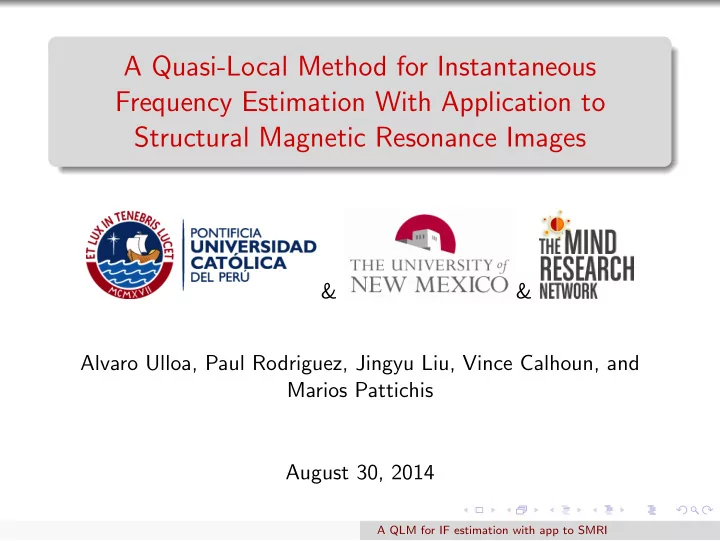

A Quasi-Local Method for Instantaneous Frequency Estimation With Application to Structural Magnetic Resonance Images & & Alvaro Ulloa, Paul Rodriguez, Jingyu Liu, Vince Calhoun, and Marios Pattichis August 30, 2014 A QLM for IF estimation with app to SMRI
Outline Background Motivation AM-FM decomposition Method comparison AM-FM decomposition of SMRI Results Conclusion A QLM for IF estimation with app to SMRI
Background Brain imaging Magnetic resonance images (MRI) Electroencephalograms (EEG) Magnetoencephalograms (MEG) Brain metrics Gray matter concentration, blood oxygenation level Electric potential Magnetic field Computational methods → case-control differences, disease prognosis and diagnosis, lesion detection, etc. A QLM for IF estimation with app to SMRI
Motivation New method for analyzing brain texture for mental diseases. Brain images are dominated by strong non-stationary behavior . The brain is formed of peaks and valleys called gyri and sulci Classical methods do not explore gyri and sulci formation, just gray matter concentration A QLM for IF estimation with app to SMRI
AM-FM decomposition The AM-FM representation of an image I ( x ) is expressed as: M � I ( x ) = a n ( x ) cos( ϕ n ( x )) (1) n =1 where x = ( x 1 , x 2 , . . . ) : pixel coordinates, M ∈ N : number of components, a n > 0 : n -th instantaneous amplitude (IA) function, ϕ n : n -th instantaneous phase (IP) function. The IF is defined as the gradient of the IP: ∇ ϕ ( x ). A QLM for IF estimation with app to SMRI
AM-FM demodulation quasi-eigenfunction quasi-local method (QLM) approximation (QEA) Initially proposed for Initially proposed for ω ( x ) ∈ [0 , π 2 ] ω ( x ) ∈ [0 , π ] Later extended for Compatible with any filter ω ( x ) ∈ [ π 2 , π ] bank design We propose ω ( x ) ∈ [0 , π ] Requires Hilbert pre-processing A QLM for IF estimation with app to SMRI
Quasi-local demodulation method QLM for ω ( x ) ∈ [0 , π 2 ] � � � R 2 ( x ) + 8 R ( x ) + ω 1 ( x ) = cos − 1 4 where 2ˇ g (1 , 1) ( x ) R ( x ) = g (0 , 1) ( x ) , ˇ g (1 , 0) ( x ) + ˇ g ( ǫ 1 , ǫ 2 ) = I ( x + ǫ 1 ) I ( x − ǫ 2 ) , ǫ 1 , ǫ 2 ≥ 0 QLM for ω ( x ) ∈ [ π 2 , π ] � � � R 2 ( x ) + 8 − R ( x ) + ω 2 ( x ) = π − cos − 1 4 A QLM for IF estimation with app to SMRI
New quasi-local demodulation method QLM for ω ( x ) ∈ [0 , π ] R ( x )+ √ � � R 2 ( x )+8 If R ∈ ( −∞ , − 1] → ω 1 ( x ) = cos − 1 4 − R ( x )+ √ � � R 2 ( x )+8 If R ∈ (1 , ∞ ] → ω 2 ( x ) = π − cos − 1 4 � ω 1 ( x ) if a ( f 1 ( x )) > a ( f 2 ( x )) If R ∈ ( − 1 , 1] → ω ( x ) = ω 2 ( x ) otherwise Where f 1 ( x ) is a low-pass filtered version of the signal and f 2 ( x ) is the counterpart. A QLM for IF estimation with app to SMRI
Method comparison A QLM for IF estimation with app to SMRI
Method comparison results QEA + filter bank QLM + filter bank ● ● ● 2 × 10 − 2 Gabor 2 × 10 − 3 Gabor ● ● Directional Directional ● ● Equirriple Equirriple ● ● 1.5 × 10 − 2 1.5 × 10 − 3 ● ● ● 1 × 10 − 2 ● 1 × 10 − 3 ● ● ● ● ● ● ● ● ● 5 × 10 − 3 ● ● 5 × 10 − 4 ● ● ● ● ● ● ● ● ● ● ● ● ● ● ● ● 0.0 0.1 0.2 0.3 0.0 0.1 0.2 0.3 Noise SD Noise SD A QLM for IF estimation with app to SMRI
AM-FM of SMRI IF angle is orthogonal to edges. IF magnitude is high at rapid variations IF characterizes sulci and gyri Figure : SMRI IF A QLM for IF estimation with app to SMRI
Dataset Table : Demographics of MCIC and COBRE studies. Site Control/Case Male/Female Age ± sd New Mexico 61/53 89/25 36 ± 12.8 Minnesota 19/30 34/15 32.2 ± 10.6 Massachusetts 24/28 32/20 38.7 ± 9.3 Iowa 60/32 59/33 31.3 ± 10 Total 164/143 214/93 34.46 ± 11.4 A QLM for IF estimation with app to SMRI
Results Voxel-wise two sample t-test of Schizophrenia patients vs healthy controls. Voxels that pass bonferroni correction. Temporal gyrus, parahippocampal gyrus and medial frontal gyrus. A QLM for IF estimation with app to SMRI
Results ANOVA by site A QLM for IF estimation with app to SMRI
Conclusion Proposed a new AM-FM demodulation method and applied it to the analysis of brain images . IF magnitude as a brain texture measure showed results coherent with previous research while being less affected by scanner settings at different collection sites This information can be used to complement SMRI studies on the effect of neuro-degenerative diseases to sulci and gyri formations. A QLM for IF estimation with app to SMRI
Recommend
More recommend